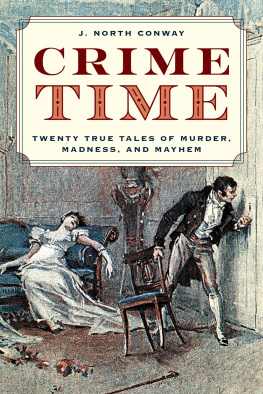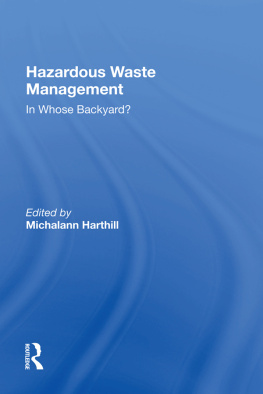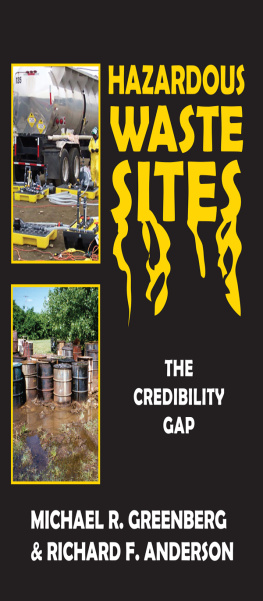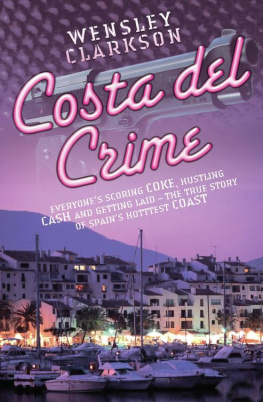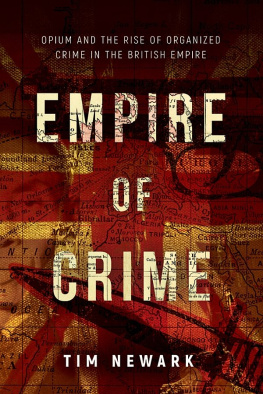DANGEROUS GROUND
DANGEROUS GROUND
THE WORLD OF HAZARDOUS WASTE CRIME
DONALD J. REBOVICH
WITH A NEW INTRODUCTION AND EPILOGUE BY THE AUTHOR
First published 1992 by Transaction Publishers
Published 2017 by Routledge
2 Park Square, Milton Park, Abingdon, Oxon OX14 4RN
711 Third Avenue, New York, NY 10017, USA
Routledge is an imprint of the Taylor & Francis Group, an informa business
New material this edition copyright 2015 by Taylor & Francis.
Copyright 1992 by Taylor & Francis.
All rights reserved. No part of this book may be reprinted or reproduced or utilised in any form or by any electronic, mechanical, or other means, now known or hereafter invented, including photocopying and recording, or in any information storage or retrieval system, without permission in writing from the publishers.
Notice:
Product or corporate names may be trademarks or registered trademarks, and are used only for identification and explanation without intent to infringe.
Library of Congress Catalog Number: 91-18199
Library of Congress Cataloging-in-Publication Data
Rebovich, Donald.
Dangerous ground : the world of hazardous waste crime / Donald
J. Rebovich. p. cm. Includes bibliographical references and index.
ISBN 1-56000-014-7
1. Offenses against the environmentUnited States. 2. Hazardous waste disposal industryUnited StatesCorrupt practices. 3. Hazardous wastesLaw and legislationUnited StatesCriminal provisions. I. Title.
HV6403.R43 1991
364.142dc20 91-18199
CIP
ISBN 13: 978-1-4128-5601-0 (pbk)
ISBN 13: 978-1-56000-014-3 (hbk)
In Memory of Mary Isabelle Mullin
Contents
It wasnt too long ago that most of us considered waste to be a common term describing all types of garbage, making no distinction between fairly innocuous and dangerous wastes. Conventional wisdom held that the ultimate destination of all waste was the local landfill. Not many gave a second thought to the chemical properties of industrial wastes mixed with household wastes dumped at the landfills. If business firms were caught dumping their wastes, it was treated as more of a nuisance rather than as a criminal act. Simply put, the common images of the criminal and the dumper were worlds apart.
We have come a long way since that time; both in terms of public awareness of the dangers of hazardous waste exposure and our willingness to accept the notion of the criminality of improper disposal. A series of ecological disasters caused by the irresponsible storage and dumping of hazardous waste has compelled us to reevaluate our thoughts on the criminality of environmental violations and has prompted our legislators to enact tough new criminal laws intended to curb these unscrupulous acts. It has now become the job of federal, state, and local law enforcement officials to see that these laws are uniformly enforcedno small task considering we know very little about who the polluters are and how they commit their crimes.
A primary objective of this book is to provide empirical information on characteristics of hazardous waste crime and the criminals themselves. Regrettably, the research community, much like the community at large of the past, has paid very little attention to hazardous waste criminality. States wishing to mobilize rigorous criminal enforcement programs have been unable to turn to research studies that could provide them with a foundation for proactive, investigative operations. In this book, I provide a historical analysis of hazardous waste crime enforcement up to the present, an assessment of hazardous waste crime and enforcement data from a number of states, projections of future patterns of hazardous waste crime, as well as some thoughts on what we can do to limit the peril posed by unchecked criminal dumping. This information will, I hope, prove to be useful in helping to target offenders and to make it less difficult to bring them to justice.
As a society, we have learned that our most damaging crime problems, such as drug abuse, cannot be ameliorated through law enforcement efforts alone. We now recognize that such problems are most effectively dealt with by focusing our attention on causation issues as we seek to establish meaningful methods of deterrence. Such is the case with hazardous waste crime. Unless we are willing to seriously explore and adopt alternatives for waste source reduction, waste recycling, and the realistic availability of legitimate waste disposal outlets, we will reduce hazardous waste crime enforcement to an exercise in futility. With this thought in mind, I caution that the information supplied in this book will be most valuable only if what we have learned is coupled with openness to new ideas on the legitimate reduction/disposal of hazardous wastes.
I am indebted to a number of colleagues who supported me through the completion of this work: David Twain, James Finckenauer, Todd Clear, John J. Gibbs, Michael Greenberg, and Freda Adler. I am particularly thankful for the guidance given to me by the late Richard Sparks. He was the source of direction for subject conceptualization and for the selection of research methods.
It is with great pleasure that I also acknowledge the considerable support I received from the New Jersey Division of Criminal Justice and the Northeast Hazardous Waste Project. Special thanks go to Robert Robillard, Linda Tartaglia, Wayne Fisher, Thomas OReilly, John Holl, Steve Madonna, James Lyko, Keith Wellks, and Philip Ahrens. The environmental law expertise of Peter Crane Anderson proved invaluable in the description of the legal structure of the states studied.
The two individuals who provided me with the most gratifying personal support were my wife, Mary Mullin, and my son, Nikolas. I thank my wife for urging me on to complete the product you now have in your hands and for overlooking my changes in temperament as I struggled to be creative. She always had great patience with me, constantly encouraging me with the words, Don, you can do it.
This book is about hazardous waste. More specifically, the book is about what hazardous waste is, how it is generated, how it is legitimately treated, and, especially, how and why it is so often illegally disposed. The book answers questions such as: Who are the offenders? What drives them to commit these offenses? What are the most common methods used for committing the offenses? How do these offenders attempt to avoid criminal enforcement detection? How successful are these individuals in getting away with these crimes? The book also shines a spotlight on the efforts used to control and deter environmental crimes involving hazardous waste. It addresses the questions here regarding: What are the government agencies responsible for controlling illegal hazardous waste dumping? Who are the people within these agencies who are entrusted with carrying out these responsibilities? What factors influence effective crime control methods? How can we enhance our abilities, as a society, to reduce hazardous waste crime commission in the future?
This book was first published at a time in which environmental crimes were making national headlines throughout the country, particularly in the northeastern United States. Groundwater was being contaminated by the wanton dumping of hazardous wastes in secluded areas. Hypodermic needles and other medical wastes were washing up along the Atlantic Coast shoreline. Spectacular fires and explosions were taking place at industrial sites where hazardous wastes were being illegally stored and disposed. One of the burning questions that was being posed at the time by the media was, Who masterminds these types of offenses? Some concluded that the strings were being pulled by members of syndicate crime organizations. However, little empirical research had been conducted to objectively examine characteristics of environmental crimes and criminals. This new edition of


